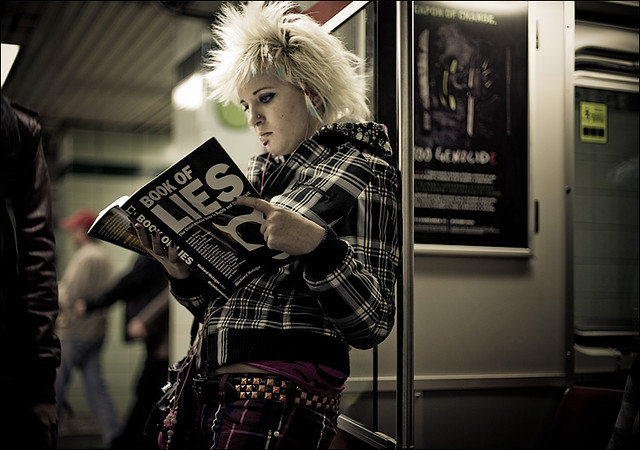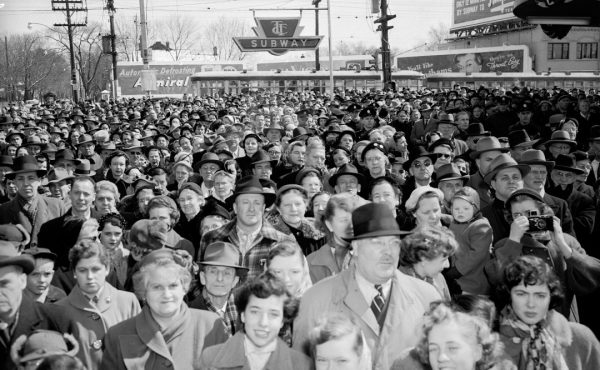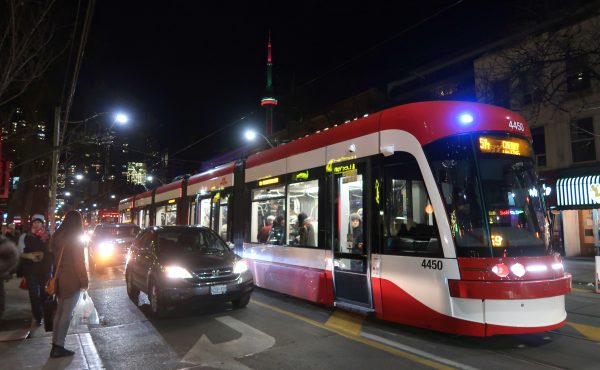

According to the mayor’s, um, outgoing chief of staff Nick Kouvalis, the Rob Ford Uptown Express to Scarborough is expected to pull into the station any minute now. “The subway deal is this close,” the National Post quoted Mr. Kouvalis as saying late last week. He apparently held his thumb enticingly close to his index finger (it’s not clear what his middle finger was up to at the time). “Transit City is alive and well and it’s going to be buried underground, OK? … So let me just finish that.”
This self-serving display of bravado aside, a cone of silence seems to have descended over the negotiations between the mayor’s office and Metrolinx over proposed revisions to the regional transit plan that would see much of the promised $8.15 billion for four Transit City lines buried beneath Sheppard Ave. A basic back-of-the-envelope calculation suggests there’s not enough cash on the table for both the subway extension and the $4.6 billion Eglinton Crosstown LRT, which, by most accounts, is the province’s line in the sand. I’d say they’re about $3 billion short.
So now what?
More precisely, is Ford prepared to emerge from his gilded cage on the second floor of City Hall and begin actively fundraising for the subway network he so desperately wants to bequeath to this city?
Let’s dispel one myth right away. Selling air rights over the proposed subway stations won’t cover more than a fraction of the additional capital costs, and that’s assuming the city has the legal right to impose such demands on builders.
The reality is that if Ford truly wants subways, he’s got to be much more assertive about building a broad-based political case that will allow the other orders to consider contributing the difference. An hefty election mandate alone won’t do the trick. Just ask Barack Obama.
The question I have is where the feds fit into his subway plans, if at all. The Harper government anted up $330 million for the Sheppard East LRT, and we’ve heard not a whisper about whether those funds will be rolled over into the subway project, or if the Fordites have even tried to persuade their buddy Jim Flaherty to throw a few more chips into the pot.
The timing for such an overture may be right, as it turns out.
Let’s cast our gaze in the direction of Quebec City, where a coalition of civic actors and Bloc MPs has resurrected a bid to secure funding for an NHL-calibre arena. The ask is all tangled up in federal/provincial negotiations over the HST, but media reports suggest that the arena boosters are also eyeballing the contents of a $1.25 billion pot of federal cash earmarked for public-private partnerships.
A source familiar with the way money flows in Ottawa suggests that renewed speculation about the arena may have to do with reports circulating around the capitol that the 2010 federal deficit may come in $7 billion less than projected, thanks in large measure to the surprisingly robust economic recovery.
Do the Brothers Ford know about this fiscal development, and are they now asking the us-too question in Ottawa? Have they seized on this opportunity to approach other big city mayors to collectively encourage Flaherty to allocate some of the un-spent stimulus funds on regional transit projects? Has the mayor used the out-bound calling feature on that magic cell phone of his to urge Toronto Liberal MPs to apply a bit of pressure in this, the all-important run-up to the federal budget?
I suspect I don’t need to supply the answers to these questions. Ford, the man whose mouth never stopped moving when he was an opposition gadfly, has fallen perplexingly silent on all matters, including the signature planks of his platform.
This close, Nick? Maybe what you really meant was, “So close but yet so far.”
photo by Sam Javanrouh




10 comments
If the TTC and the City were serious about leveraging air rights, they would have designed the Spadina Extension stations with integrated multistorey buildings (which could have acted as community hubs on lower levels with library branches and so on). One of these buildings could have housed the relocated TTC HQ instead of a prime commercial site at York Mills. The York U one could have had a student residence or other university facility.
Instead we got the same old 1-2 storey build on a subway which should never have been approved past Steeles were it not for the then Provincial Finance Minister representing a York riding.
Asking “who will pay” is always a fair comment John. But what I don’t get is why LRT is okay but BRT’s or subways aren’t. LRT’s certainly aren’t “cheap”. And if moving people is the true goal of public transportation then one can easily make the case for BRT’s as opposed to LRT’s from a financial point of view. LRT’s might even be considered the worst of both worlds – not as cheap as BRT and not as fast/quick as HRT/Subways.
There is also something else that doesn’t sit right. A certain commercial for a national newspaper shows a little girl riding her bicycle talking about how we should strive to do great things and to dream the impossible. I sit there and I think to myself about Japan’s Seikan Tunnel which is 53kms under the sea. I think about the Gotthard Tunnel and how they built 56kms under the Alps largely because they want to preserve the “scenery” of the Alps between Switzerland and Italy. And it just blows me away that when Rob Ford wants to FINISH (not “build”) 13km of subway under Sheppard Ave to allow rapid transportation for those who can’t afford to live downtown….it is somehow absolutely impossible and whoever advocates it must ridiculed mercilessly until they come to their senses and appreciate that an LRT is the only method that works anywhere in the world!
Perhaps the Globe should re-evaluate the opinions of the columnists who write for them (ahem. M.Gee) in order to put out a consistent message that fits with their line of advertising in the crowded newspaper market lest they be seen as complete hypocrites. Thinking big should be encouraged – as that is how great things happen.
Transit City was thinking big, JW — and it went beyond just thinking, to actual funding and readiness for implementation. Anyone can make pie-in-the sky fantasies… why stop at subways? Why not flying cars, or teleportation? Reality is a consideration. The simple fact is that subways cost at least an order of magnitude more than LRT. BRT is a good solution in certain circumstances, but buses carry far fewer passengers than RT cars.
Paul – why are subways “pie in the sky fantasies”? I haven’t seen flying cars or teleportation. I have seen subways. In London. In New York. Paris. Tokyo. In fact, I think I’ve even seen them in…..Toronto!
Also, let’s not deal in hypotheticals. True LRT would be great. But Transit City is not true rapid transit. It is meant to regenerate rundown neighbourhoods. It has a lot more in common with St. Clair than it does to any subway. There are too many stops in the Transfer City plans and without signal priorty (which goes hand in hand with speed) it will feel more like we are backpacking in Spain on a leisure ride than as a viable alternative to using the car in order to get to work.
Subways are a standard metropolitan vehicle for transit. They’re a banal mode of transportation that has been around for about a century. Unsurprisingly, we have a network, it’s well-liked, it moves a lot of people, and it needs to be expanded! We should definitely improve surface transit in the suburbs by implementing LRT, but not neglect subway expansion; it’s the best way to get around quickly. Some smaller cities have LRT lines as a backbone and they work well, running in their own dedicated corridors with streets closed to traffic downtown and, but that’s not the direction we would take because we have the subway network as the backbone, that should be incrementally expanded along with other transit initiatives like LRT. A one or the other mentality isn’t going to help us achieve a great system.
Sheppard makes sense for subway because we already started building a subway line, and it has worked out well. Our dense suburban centres should be connected via the fastest transit, because the distances are far, yet there are a lot of reasons for people to use transit with a high concentration of residences, employment, and culture.
Essentially, when it comes to our subway network, I think we should grow a backbone.
Its a very simple question of mathematics. A subway is designed to carry at least 10 000 people per hour per direction, preferably closer to 30 000. These are the kind of numbers we see on parts of the subway network built before the 1980s. Using those numbers, one has to simply admit that for the time being, we have subways where we need them. If we will so desperately need a subway under Sheppard in 2031 (and not because demand will have increased on the subway built there in 2015- that kind of circular logic works on any line drawn anywhere on the map; why don’t we build a subway under Bathurst street? It’ll be busy by 2031, I swear!) then we should plan to build it 10 or 20 years from now when a defendable case could be made for it. Right now, not only can we not afford it, we just don’t need it. And if you are so desperate for a subway, then ask why under Sheppard? There is a whole lot more ridership elsewhere in the city, try Eglinton, Dufferin, Finch, even Jane, not to mention downtown thoroughfares like King and Queen where buses (streetcars) consistently come more often and more full than on Sheppard.
JW, you’re propagandizing at this point and I’m not going to engage beyond these final comments.
Transit City was/is a bigger idea than Ford’s subway pipe dream because it was a network that would serve the whole city.
An equivalent subway network is a pipe dream because it would cost hundreds of billions of dollars. In the current (and foreseeable) political and economic climate there is not a chance it would ever come to pass.
An “order of magnitude” typically means a factor of 10, two orders of magnitude = factor of 100, three = factor of 1000, and so on.
Thus, at a factor of around 4 or 5, subways exceed the cost of LRT by considerably less than an order of magnitude.
Yes, a cone of silence has been suspended over the GTA’s regional planning process. Just like the olde days…
When it lifts, do the citizens get to join in?
Will there be a new debate, more consultation?
Are the stakeholder groups on Metrolinx’s list being consulted right now?
The Big Move was not exactly a clean-slate or entirely objective process, but it was a more public transport planning exercise than any I have heard of here. Now we are remaking it based upon simple election slogans and unknown lobbying efforts behind the scenes.
And if Ford’s argument of no new surface transit improvements is championed — does that kaibosh all non-subway transit upgrades for the forseeable future, because they might inconvenience car drivers?
Not even bus lanes? Anywhere in 416?
We do not have subways where we need them, as the existing lines are very crowded at various points during the day. We need at least one new downtown line to relieve the existing lines, as well as links between suburban centres. We’re not at the breaking point yet, but it’s misguided to wait until then.
As for Sheppard, it’s busy now. Sheppard may not have been the ideal first place for a new line, but it works, and phase one is completed. Now it’s time to finish the rest of it. Link the U-line branches, connect the centres of density in the suburbs and promote rapid urbanization. Relieve the 401.
It’s going to be a big and long-term investment following a thirty to fifty year plan, but one that will allow the densest city with the fastest and most efficient transit to be built. It’s not precluding any surface route upgrades to vehicles in dedicated lanes in the short term future, either, unless the mayor is prejudiced against them. That kind of ignorant attitude will only hurt the city. Yet it must not be forgotten that we need to stop neglecting the subway network as we improve our surface routes.